Wai-Fah Chen.The Civil Engineering Handbook
Подождите немного. Документ загружается.

Urban Drainage
32
-3
In the rational method, the peak rate of surface flow from a given watershed is assumed to be
proportional to the watershed area and the average rainfall intensity over a period of time just sufficient
for all parts of the watershed to contribute to the outflow. The rational formula is shown in Eq. (32.1)
Q
=
CiA
(32.1)
where
Q
= the peak discharge (cfs)
C
= the ratio of peak runoff rate to average rainfall rate over the watershed during the time
of concentration (runoff coefficient)
i
= the rainfall intensity (inches/hour)
A
= the contributing area of the watershed (acres).
It should be noted that
C
has units.
The rational method is usually applied to drainage basins less than 200 acres in area, but should be
used carefully for basins greater than five acres. The basic assumptions used in the rational formula are
as follows: (1) The rainfall is uniform over the watershed. (2) The storm duration associated with the
peak discharge is equal to the time of concentration for the drainage area. (3) The runoff coefficient
C
depends on the rainfall return period, and is independent of storm duration and reflects infiltration rate,
soil type and antecedent moisture condition. The coefficient
C
, the rainfall intensity
i
and, the area of
the watershed,
A
, are estimated in order to use the rational method.
Runoff Coefficient
The runoff coefficient
C
reflects the watershed characteristics. Values of the runoff coefficient
C
are found
in drainage design manuals (Burke et. al., 1994, ASCE, 1992) and in textbooks (Chow et al. 1988). If a
watershed has different land uses, a weighted average
C
based on the actual percentage of lawns, streets,
roofs, etc. is computed and used. Values of
C
must be carefully selected. The
C
values usually found in
manuals and textbooks are valid for recurrence intervals up to 10 years. These values are sometimes
altered when higher rainfall frequencies are used.
Rainfall Intensity
Rainfall intensity-duration-frequency curves are used to determine rainfall intensities used in the rational
method. Local custom or drainage ordinances dictate the use of a particular return period. In the design
of urban drainage collection and conveyance systems, a return period of 5 to 10 years is generally selected.
In high value districts (commercial and residential) and in flood protection works, a 50 or 100 year
frequency is used. When more than one return period is used, the costs and risks associated with each
return period must be scrutinized. In the rational method, the storm duration is equal to the time of
concentration. Further details on risk/reliability models for design are found in Tung et al. (2001).
Time of Concentration and Travel Time
The
time of concentration t
c
is the time taken by runoff to travel from the hydraulically most distant point
on the watershed to the point of interest. The
time of travel T
t
is the time taken by water to travel from
one point to another in a watershed. The time of concentration may be visualized as the sum of the
travel times in components of a drainage system. The different components include overland flow, shallow
concentrated flow and channel flow. As an area is urbanized, the quality of flow surface and conveyance
facilities are improved, and the times of travel and concentration generally decrease. On the other hand
ponding and reduction of land slopes which may accompany urbanization increase times of travel and
concentration.
Overland flows are assumed to have maximum flow lengths of about 300 ft. From about 300 ft. to the
point where the flow reaches well-defined channels, the flow is assumed to be of the shallow concentrated
type. After the flow reaches open channels it is characterized by Manning’s formula.
© 2003 by CRC Press LLC
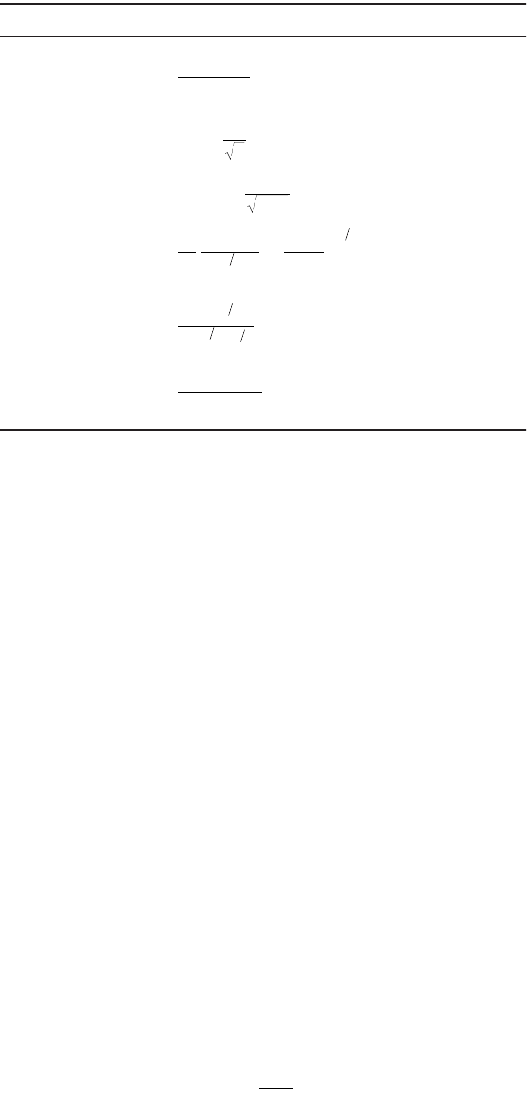
32
-4
The Civil Engineering Handbook, Second Edition
Some commonly used formulas employed in the determination of the overland flow travel time are
shown in Table 32.2. Most of these equations relate the overland time of travel to the basin length, slope
and surface roughness. Two equations, by Izzard and Regan, include rainfall intensity as a factor, which
necessitates an iterative solution.
The average velocities for shallow concentrated flow are estimated by Eqs. (32.2) and (32.3) for unpaved
and paved areas respectively, where
V
is the average velocity in ft/sec. and
S
is the slope of the land surface
in ft/ft. (SCS, 1986).
unpaved:
V
= 16
.
13
(
S
)
0.5
(32.2)
paved:
V
= 20
.
33
(
S
)
0.5
(32.3)
Flows in open channels are characterized by Manning’s formula. In sewered watersheds, the time of
concentration is calculated by estimating the overland flow travel time, which is called the
inlet time
, the
gutter flow time and the
time of travel in sewers
. Often, the
inlet time
, which is the time taken by water
to reach inlets, is assumed to be between 5 and 30 min. In flat areas with widely spaced street inlets, an
inlet time of 20 to 30 min is assumed (ASCE, 1992). These inlet times are added to the flow time in the
sewer or channel to determine the travel time at a downstream location.
The flow time in sewers is usually calculated by choosing a pipe or channel configuration and calcu-
lating the velocity. The time is then found by:
(32.4)
where
t
= the travel time in the sewer (min.)
L
= the length of the pipe or channel (ft)
V
= the velocity in the sewer (ft/sec)
TABLE 32.2
Equations for Overland Flow Travel Time
Name Equation for
t
t
Notes
Regan (1972)
n
is Manning’s
roughness coefficient
Kerby (1959)
L
< 1200 ft,
Federal Aviation
Agency (1956)
Airport areas
C
= runoff coefficient
Izzard (1946)
iL
< 500,
or
Overton and
Meadows (1970)
where
t
t
= the overland flow time (min),
L
is the basin length (ft),
S
= the basin slope (ft/ft),
i
is the rainfall intensity (in./hr),
c
= the retardance coefficient and
C
is the runoff coefficient,
n
=Manning’s
n
,
P
2
= the 2 year-24 hr rainfall (in)
K
=56
N
=a roughness coefficient
t
Ln K
iS
t
=
06 06
04 03
..
..
t
NL
S
t
=
È
Î
Í
˘
˚
˙
0 827
0 467
.
.
tC
L
S
t
=-
()
1811
100
..
t
ic
S
L
iL
t
=
+
È
Î
Í
˘
˚
˙
-
2
60
0007
43200
13
23
.
t
cL
Ci S
t
=
()
41
13
23
13
t
nL
PS
t
=
()
()
0 007
08
2
05
04
.
.
.
.
t
L
V
=
60
© 2003 by CRC Press LLC

Urban Drainage
32
-5
Mannings’ formula is commonly used to estimate the travel times in sewers. The sewer is assumed to
flow full and a velocity is computed. Manning’s
n
values commonly used for this purpose are found in
Chow (1959). Sometimes, natural channels are used to convey storm runoff. In these cases the velocities
given in Table 32.3 (AASHTO, 1991) may be used in Eq. (32.4). The drainage area,
A,
used in the rational
formula is determined from topographic maps and field surveys.
Application of the Rational Method
The choice of parameters in the rational method is subjective. Consequently, variations occur in designs.
Since rainfall intensity values are derived from statistical analyses and may not represent actual storm
events, it is impossible to have a storm of a specified design intensity and duration associated with the
results from the rational method. The procedure for the application of the rational method is as follows:
(1) The contributing basin area
A
(acres) is determined by using maps or plans made specifically for the
basin. (2) By using the land use information, appropriate
C
values are determined. If the land has multiple
uses, a composite
C
value is estimated by Eq. (32.5):
(32.5)
where
C
1
, C
2
… C
n
= the runoff coefficients associated with the A
1
, A
2
… A
n
respectively
A = the sum of A
1
, A
2
… A
n
(3) The time of concentration is estimated by summing the travel time components. (4) The rainfall
intensity is determined by using an intensity-duration-frequency diagram and the time of concentration
as the storm duration. (5) The peak runoff (cfs) is computed by multiplying C, i and A. (6) If there is
another basin downstream, the time of concentration from the upstream basin is added to the travel
time in the channel. This time of concentration is compared to the time of concentration of the second
basin and the larger of two is used as the new time of concentration. Examples of the application of
rational method are found in Burke et al. (1994). Because of the assumptions and the simplistic approach
on which rational method is based, its application is not recommended for watersheds larger than five
acres.
32.3 The Soil Conservation Service Methods
The Soil Conservation Service has developed a method to estimate rainfall excess P
e
from total rainfall P,
based on the total ultimate abstraction S. In this method, P
e
is given by Eq. (32.6), where P must be
greater than 0.2S, which is the initial storage capacity I
a
(in.).
(32.6)
TABLE 32.3 Typical Velocities in Natural Waterways (AASHTO, 1991)
Ve l o city In
Average Slope
of waterway (%)
Natural Channel
(not well defined)
(ft/sec)
Shallow Channel
(ft/sec)
Main Drainage
Channel
(ft/sec)
1–2
2–4
4–6
6–10
1.5
3.0
4.0
5.0
2–3
3–5
4–7
6–8
3–6
5–9
7–10
—
C
CA C A CA
A
comp
nn
=
++º
()
11 2 2
P
PS
P
e
=
-
()
+
02
085
2
.
.
© 2003 by CRC Press LLC

32-6 The Civil Engineering Handbook, Second Edition
If P is less than 0.2S, P
e
is assumed to be zero. The rainfall excess P
e
has units of inches. In this method,
the abstraction S is related to the “curve number” CN as in Eq. (32.7)
(32.7)
The curve number CN is also related to soil types and land uses. Soils are divided into four classes A
through D, based on infiltration characteristics. Type A soils have the maximum and D soils the minimum
infiltration capacity with B and C soils falling in between. Tables containing soil names and types are
available in SCS (1972) and a portion of this table is shown in Table 32.4. Curve numbers for selected
land use and Antecedent Moisture Condition (AMC (II) (SCS, 1972) are shown in Table 32.5.
Application of the SCS Method
In order to use this method, the area A is subdivided into subareas A
1
, A
2
,… A
n
so that each of the
subareas has a uniform land use. By identifying the soil types and land uses in each of these subareas,
the CN values for the subareas are estimated from Table 32.5. The rainfall excess P
e
is computed by
Eq. (32.6). A rainfall excess hyetograph may then be computed by using the Huff curves as discussed in
TABLE 32.4 Soil Classification Table (SCS, 1972)
Name Class Name Class Name Class
Abscota
Digby
Ade
A
B
A
Bewleyville
Door
Birds
B
B
(C/D)
Check to Waga
Cincinnatic
Chetwynd
D
C
B
TA BLE 32.5 Runoff Curve Numbers for Selected Land Uses
Land Use Description
Hydrologic Soil Group
ABCD
Cultivated land
a
: without conservation treatment with
conservation treatment
72
62
81
71
88
78
91
81
Pasture or range land: Poor condition good condition 68
39
79
61
86
74
89
80
Meadow: good condition 30 58 71 78
Wood or forest land: thin stand, poor cover, no mulch
good cover
2
45
25
66
55
77
70
83
77
Open Spaces, lawns, parks, golf courses, cemeteries, etc.
good condition: grass cover on 75% or more of the area
fair condition: grass cover on 50% to 75% of the area
39
49
61
69
74
79
80
84
Commercial and business areas (85% impervious) 89 92 94 95
Industrial districts (72% impervious) 81 88 91 93
Residential
Average lot size
1/8 acre or less
1/4 acre
1/3 acre
1/2 acre
1 acre
Average% impervious
65
38
30
25
20
77
61
57
54
51
85
75
72
70
68
90
83
81
80
79
92
87
86
85
84
Paved parking lots, roofs, driveways, etc. 98 98 98 98
Streets and roads:
Paved with curbs and storm sewers
Gravel
Dirt
98
76
72
98
85
82
98
89
87
98
91
89
Antecedent moisture condition II, I
a
= 0.2S.
Source: SCS (1972).
S
CN
=-
1000
10
© 2003 by CRC Press LLC

Urban Drainage 32-7
Section 31.2. The rainfall excess hyetograph thus generated may be used with the SCS - unit hydrograph
method to compute a direct runoff hydrograph. The direct runoff hydrograph can be used to size
collection and conveyance systems and to estimate detention storage volumes, Mays (2001).
32.4 Detention Storage Design
The increased runoff volume produced by the urbanization of watersheds can result in downstream
flooding. Storage facilities are designed to receive runoff from developed upstream watersheds and release
it downstream at a reduced rate. This reduced rate is determined by using parameters fixed by local
ordinance or by calculating the available capacity of the downstream storm sewer network. Some of the
methods used to compute the required storage volumes of detention storages are discussed in this section.
Types of Storage Facilities
Storage facilities can be divided into two general categories as detention and retention. These are also
called as dry or wet detention ponds. Detention storage is the temporary storage of the runoff that is in
excess of that released. After a storm ends, the facility is emptied and resumes its normal function. Ponds,
parking lots, rooftops and parks are common detention facilities, which may be designed to temporarily
store a limited amount of runoff.
Retention facilities are designed to retain runoff for an indefinite period of time. Water level in retention
facilities changes only due to evaporation and infiltration. Ponds and lakes are examples of retention
facilities that are used in subdivisions to enhance the overall project.
Computation of Detention Storage Volumes
The primary goal in the design of detention facilities is to provide the necessary storage volume. If
infiltration and evaporation are neglected during the runoff period, the continuity equation for a deten-
tion pond may be written as in Eq. (32.8),
(32.8)
where I(t) = inflow to the pond from the sewer network at time (t) (cfs)
O(t) = outflow from the pond into the downstream drainage network at time (t) (cfs)
DS =change in storage (ft
3
) in time interval Dt (sec)
Dt =time interval
Equation (32.8) may also be written as:
(32.9)
where subscripts 1 and 2 denote the flows and storages at times t
1
and t
2
.
When inflow and outflow hydrographs are known, the largest value of S
2
– S
1
found in Eq. (32.9) is
the required storage. The following is a discussion of some of the methods used to estimate detention
storage volumes. For retention facilities the outflow rate is equal to the sum of the evaporation and
infiltration rates. These are negligible during a storm and the required volume is therefore equal to the
runoff volume.
Storage Determination By Using the Rational Method
The rational method discussed previously is extended to compute detention storage volumes by multi-
plying the peak flow rate by the storm duration. The allowable peak flow rate (release rate) leaving the
It Ot
S
t
()
-
()
=
D
D
II
t
OO
t
SS
12 1 2 21
22
+
()
-+
()
=-
DD
© 2003 by CRC Press LLC
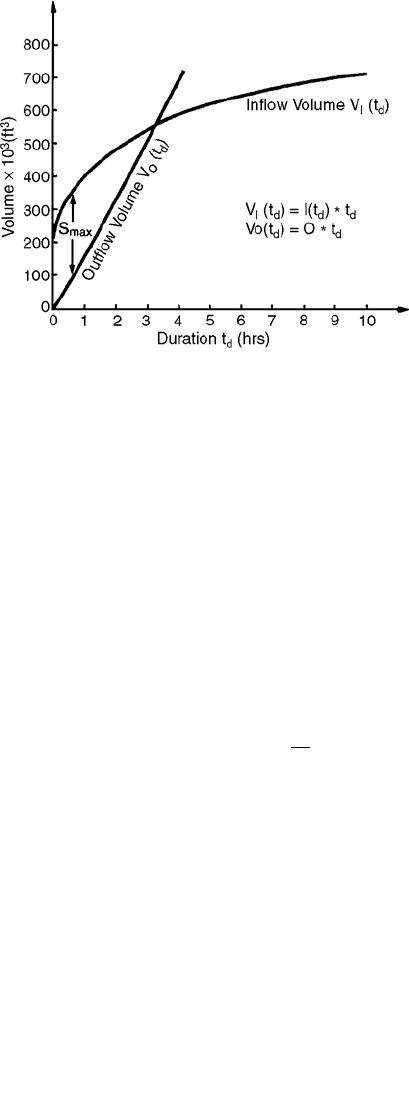
32-8 The Civil Engineering Handbook, Second Edition
detention pond, O(t), is calculated by using the contributing undeveloped area, A
U
, the runoff coefficient
applicable for undeveloped condition C
U
, and rainfall intensity, i
U
, associated with the time of concen-
tration of the undeveloped basin. The return period for the intensity i
U
is normally fixed by local
ordinances or is based on the design parameters of the larger downstream drainage network. The
allowable outflow rate is assumed to remain constant for all storm durations, t
d
. Therefore the volume
corresponding to t
d
, v(t
d
), is the product of O(t) and t
d
. This is illustrated in Fig. 32.2 where the lines
V
I
(t
d
) and V
0
(t
d
) are the inflow and outflow volumes at times t
d
.
The rate of inflow to the detention basin, I(t), is calculated by using the contributing developed area,
A
D
, the developed runoff coefficient, C
D
, and a rainfall intensity, i
D
, corresponding to storm duration,
t
d
, and the return period. Thus, for various durations, the peak flow and the volume of runoff are
computed. The maximum difference between the inflow and outflow volumes is the required detention
pond storage. This is shown in Fig. 32.2 as S
max
. The method may also be expressed as in Eq. (32.10),
(32.10)
where S(t
d
) = the required storage (acre - ft)
t
d
= the storm duration in hours.
Various storm durations, t
d
, are selected and the largest value of S(t
d
) is selected as the required volume
of the detention pond.
The procedure to size detention storage facility by using the rational method is as follows: (1) The
area, A
U
, runoff coefficient, C
U
, and time of concentration for the undeveloped site are determined. By
using the appropriate intensity-duration-frequency curve, the intensity, i
U
, corresponding to the return
period for the allowable outflow rate is estimated. (2) The runoff (O) from the undeveloped site (O =
C
U
i
U
A
U
) is computed. (3) The runoff coefficient corresponding to the developed conditions, C
D
is
estimated. (4) The rainfall intensities (i
d
) for various durations, (t
d
) are obtained for different return
periods. Recommended durations are 10, 20, 30, 40, 50 min. and 1, 1.5, 2, 3, 4, 5, 6, 7, 8, 9 and 10 hours.
(5) The inflow rate to the detention pond, I(t
d
) = C
D
i
d
A
D
is computed. (6) The required storage for
each duration, is calculated. (7) The largest volume S(t
d
) is selected as the design volume.
Various agencies have set guidelines for selection of i
U
, i
D
, C
U
and C
d
. For example, the Metropolitan
Water Reclamation District of Greater Chicago (MWRDGC), uses the criteria that i
U
should be is based
on a 3-year return period, i
d
is based on a 100-year return period, C
U
should be less than or equal to
0.15 and C
D
should be 0.45 for pervious areas and 0.9 for impervious areas.
FIGURE 32.2 Graphical representation of storage volumes as determined by the rational method.
St C i A CiA
td
dDDDuuu
()
=-
[]
12
© 2003 by CRC Press LLC
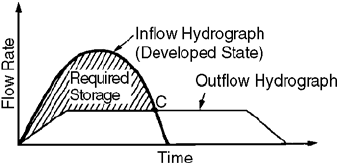
Urban Drainage 32-9
It may be impossible to collect and convey all of the runoff from a given watershed under certain
conditions. The result is that some runoff is discharged directly into the downstream drainage network
without being detained. To compensate for this unrestricted release, the allowable release rate, O, is
reduced by that amount.
Soil Conservation Service Hydrograph Method
Methods were discussed in Section 32.3 by which the stormwater runoff hydrographs can be estimated
by the SCS method. These hydrographs are used to compute detention storage volume.
As previously described, the difference between the inflow from the developed watershed and the
allowable outflow from a detention pond is the required storage volume. The outflow is determined by
using characteristics of the undeveloped watershed and a rainfall frequency equal to or less than that
which a receiving system can handle, or is prescribed by local ordinance.
Figure 32.3 shows an inflow and a outflow hydrographs. The difference between the hydrographs,
which is the required storage, is shown as the shaded region. At point C, the detention pond inflow rate
is equal to the outflow rate when it will start to empty. In Fig. 32.3 the outflow rate is assumed to remain
constant. The outflow rate will depend upon the depth of water in the pond and the type of outlet
structure (i.e., weir, orifice or pipe). It should also be noted that for a detention pond, the inflow and
outflow volumes are equal.
The following is an outline of the procedure used to determine the required storage volume by the
SCS hydrograph method. (1) Calculate the curve numbers for the basin in developed and undeveloped
condition. (2) Find the time of concentration t
c
for the basin in undeveloped and developed condition.
(3) From t
c
, calculate the duration of the unit hydrograph DD, t
p
and q
p
for the developed and undeveloped
basins. (4) Determine the coordinates of the inflow and outflow unit hydrographs. (5) From the design
storm duration, depth, time distribution and frequency, calculate the cumulative rainfall at DD intervals
for both the undeveloped and developed states. (6) Using the basin curve number and ultimate abstraction
S, calculate the cumulative runoff, P
e
(t
d
) at each DD interval by using the rainfall data in Step 5.
(7) Calculate the storm hydrographs by using the effective rainfall and direct runoff data. (8) Using the
peak flow from the undeveloped state as the peak outflow, calculate the outflow hydrograph as determined
by the type of outflow structure. (9) Calculate the required storage by using the developed hydrograph
and outflow data or by using routing methods.
Detention Storage Layout
Once the amount of detention storage is determined, a storage facility must be designed to accommodate
the inflow of runoff and control the release rate. Typical detention storage layout consists of providing
a detention pond with the inflow on one side of the pond and the outlet on the other side of the pond.
The first criterion in sizing a detention pond is to determine the outlet elevation that is usually controlled
by the elevation of the downstream receptor. The downstream receptor may be a storm sewer, water
body (i.e., pond, lake, stream or channel) field tile or culvert. The hydraulic conditions of the downstream
receptor must be analyzed to determine if there will be any tailwater effects (depending on the design
conditions) on the outlet of the detention storage facility. Knowing the outlet elevation of the downstream
receptor will give a good approximation of the elevation of the detention pond restrictor elevation. The
FIGURE 32.3 Inflow and outflow hydrographs for a hypothetical detention pond.
© 2003 by CRC Press LLC
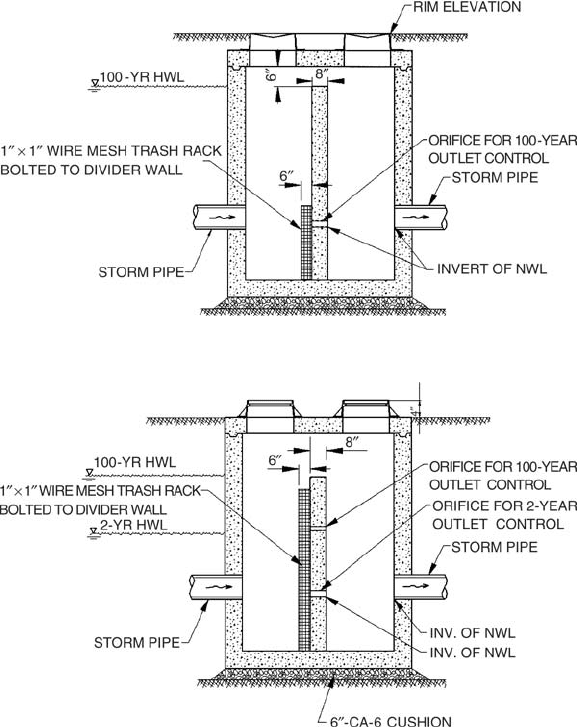
32-10 The Civil Engineering Handbook, Second Edition
designer needs to decide whether the pond will be wet bottom or dry bottom depending on site char-
acteristics (i.e., groundwater table, soil characteristics, surrounding land use, etc.). The detention pond
size and layout can then be determined accounting for the site topography and available area.
The next step in designing the detention pond is to determine the restrictor size. When the regulations
require a single outlet release rate for a given storm event and duration, a restrictor size is determined
using the orifice equation. The restrictor is placed at the bottom elevation of the pond. Or, in the case
of a wet bottom pond, at the normal water level. Figure 32.4 shows an example of a restrictor drilled
through a wall constructed inside a manhole. Some regulatory agencies require a 2-stage restrictor outlet
control. For example, the 2-year release rate is set at 0.04 cfs per tributary acre and the 100-year release
rate is set at 0.15 cfs/acre. In this situation the 2-year release rate restrictor is set at the bottom of the
pond and the 100-year release rate restrictor is set at the 2-year high water elevation. Figures 32.5 and
32.6 show two examples for the 2-stage restrictor outlet controls.
Because the controlled rate is often low, it is not uncommon to have a very small restrictor size, even
in the range of 1 to 2 in. for smaller tributary areas and 5 to 6 ft of bounce (elevation between the design
normal water level and high water level. Some regulatory agencies require a minimum restrictor size of
4 in. For those agencies that do not have a minimum and where the restrictor size is small, it is important
to protect the opening from being blocked and provide for an overflow weir that conveys the overtopping
FIGURE 32.4 Detention basin control structure for single release rate.
FIGURE 32.5 Detention basin control structure with concrete wall for dual release rate. NWL is the normal water
level.
© 2003 by CRC Press LLC
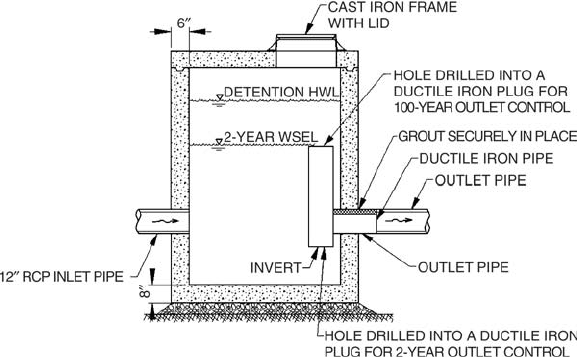
Urban Drainage 32-11
water to the downstream receptor. Figure 32.5 has a trash rack to collect any debris from blocking the
restrictor and an overflow weir set at the high water level.
In areas where the value of the land is high enough that it is too costly to use a sizeable portion of the
project site for a detention storage pond there are several alternatives. The first alternative is to refine
the pond layout by using retaining walls on some or all sides of the detention pond. Another more costly
alternative is to provide underground storage.
Underground storage is expensive but an economic decision that the property owner may choose to
consider. The storage is usually obtained by providing laterals of storm sewers laid next to each other or
by providing an underground storage vault, which could consist of concrete box culverts. The choice of
storm sewer material for underground storage is one of either concrete, corrugated metal or high-density
polyethylene. Pipe manufacturers have recently come out with some more efficient layouts that maximize
the amount of storage provided for each lateral. There are benefits and concerns for each of the three
types of storm sewers that provide underground detention that must be weighed by the design engineer
for the circumstances of the particular application. Some things for the design engineer to consider when
selecting the underground storage option are: conflicts with existing or proposed utilities, the experience
of the contractor installing the system and the loads on top of the storm sewer system.
Defining Terms
Rational method — A method to estimate peak runoff from small watersheds.
Time of concentration — Time taken by runoff to travel from the hydraulically most distant point on
the watershed to the point of interest.
Inlet time — Time taken by water to reach inlets.
Detention storage — Storage used to temporarily store storm water and to release it gradually after the
storm is over.
Retention storage — A facility to store storm water. The stored water is allowed to infiltrate and
evaporate.
References
AASHTO (American Association of State Highway and Transportation Officials) (1991) “Model Drainage
Manual,” Suite 225, 444 N. Capitol St.N.W., Washington, D.C., 20001.
ASCE (1992) “Design and Construction of Urban Stormwater Management Systems,” ASCE, New York.
FIGURE 32.6 Detention basin control structure with ductile iron plug for dual release rate.
© 2003 by CRC Press LLC
32-12 The Civil Engineering Handbook, Second Edition
Burke, C.B. and Burke, T.T. Jr., (1994) “Stormwater Drainage Manual,” Tech. Rept. H-94–6, Highway
Extension and Research Project for Indiana Counties and Cities, Purdue University, Civil Engi-
neering Building, W. Lafayette, IN.
Chow, V. T., (1959) Open Channel Hydraulics, McGraw-Hill, New York.
Chow, V. T., Maidment, D.R. and Mays, L.W. (1988) Applied Hydrology, McGraw-Hill, New York.
HEC (Hydrologic Engineering Center), U.S. Army Corps of Engineers, (1985) “HEC-1, Flood Hydrograph
Package, Users Manual,” Davis, CA.
Kuichling, E., (1889) “The Relation between the Rainfall and the Discharge of Sewers in Populous
Districts,” Trans. ASCE, 20, pp. 1–56.
Landsburg, H.E. (1981) The Urban Climate, Academic Press, New York.
Lowry, W. P. , (1967) “The Climate of Cities,” Sci. Am. 217(2), 15–23.
Mays, L.W. (2001) Ed. Stormwater Collection System Design Handbook, McGraw-Hill, New York.
SCS (1982) “TR-20 Computer Program for Project Formulation Hydrology,” Tech., Release No. 20,
Washington, D.C., May.
SCS (1986) (USDA Soil Conservation Service), “Urban Hydrology for Small Watersheds,” Technical
Release No. 55 (TR-55), Washington, D.C.
Soil Conservation Service (1972) National Engineering Handbook, Washington, D.C.
Tung, Y-K, L.W. Mays and B.C. Yen (2001) “Risk/Reliability Models for Design,” Chapter 22, Storm Water
Collection Systems Design Handbook, L.W. Mays, editor, McGraw-Hill, New York.
Further Information
American Society of Civil Engineers (ASCE) and Water Environment Federation (WEF) (1992) “Design
and Construction of Urban Stormwater Management Systems,” Reston, VA.
Kibler, D.F., ed. (1982). “Urban Stormwater Hydrology,” Water Resources Monograph 7, American Geo-
physical Union, Washington, D.C.
Mays, L.W., ed. (2001). Water Resources Engineering, John Wiley & Sons, New York.
Mays, L.W., ed. (2001). Stormwater Collection System Design Handbook, McGraw-Hill, New York.
Stahre, P., and B. Urbonas (1990) Storm-water Detention for Drainage, Water Quality, and CSO Manage-
ment, Prentice-Hall, Englewoods Cliffs, NJ.
Ye n, B.C., and A.O. Akan (1999) “Hydraulic Design of Urban Drainage Systems,” chap. 14 in Hydraulic
Design Handbook, L.W. Mays (ed.), McGraw-Hill, New York.
© 2003 by CRC Press LLC
